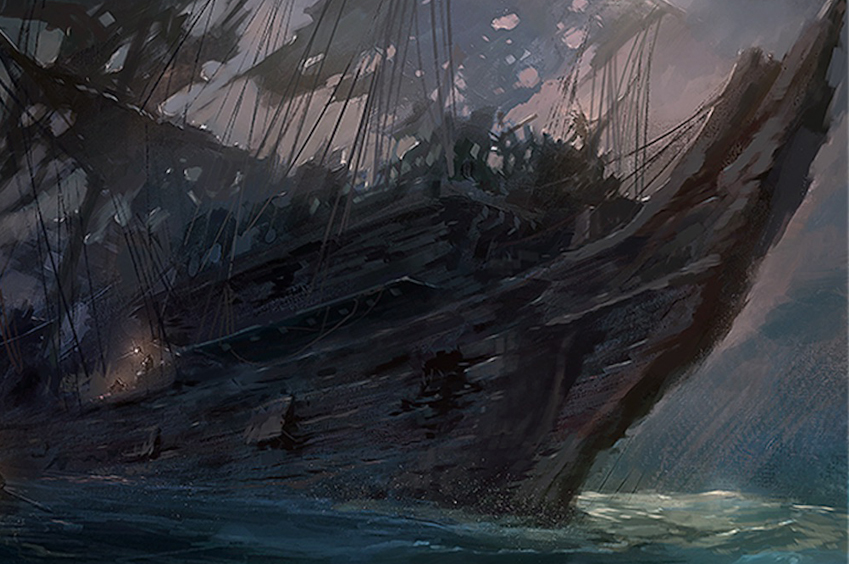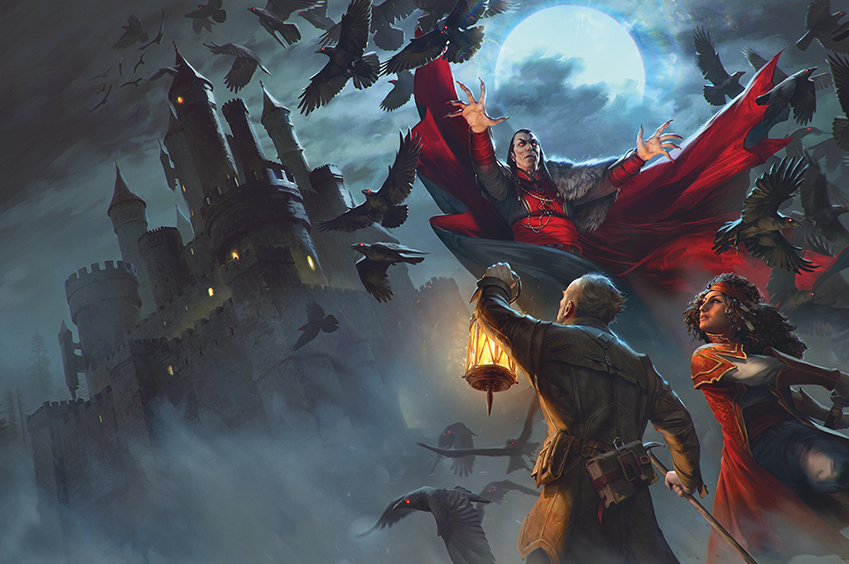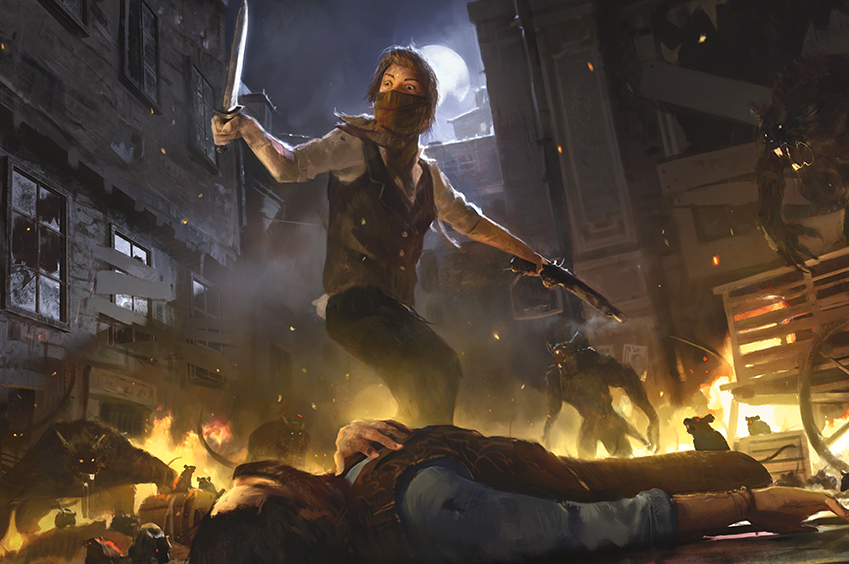Battles are the moments that many Dungeons & Dragons DMs and players live for, but they can also become routine. The players and monsters roll initiative, take hits at each other, use magic, miss or connect, and then repeat until one side goes down or escapes.
There’s nothing wrong with this in theory, but if you want to introduce a degree of dynamism into even the most mundane of random encounters, one way to do so is to utilize environmental hazards.
When we think of what hazards mean in D&D, we too often only imagine the rogue stopping at a dungeon door to roll an Investigation check, or perhaps the druid creating difficult terrain with Spike Growth. But there are a plethora of other ways that we can integrate these features into our games, and before I plot out any combat scenario, I like to ask the following questions:
- Where is this combat taking place, and are there any traps, obstacles or other assorted “gimmicks” nearby that might naturally come into play?
- Take a brief tour of the environment: What’s in the sky? What’s on the ceiling? The walls? What’s the ground like? Quick decisions about small details can provide new dimensions to an encounter.
- Can both the players and the monsters be affected by these elements during the fight?
Let’s look at how these questions helped me amp up fights in three separate campaigns. Warning - light spoilers describing battles in Icewind Dale: Rime of the Frostmaiden, Ghosts of Saltmarsh, and Curse of Strahd await.
A Wall of Spikes and a Zombie Kebab
Icewind Dale: Rime of the Frostmaiden features an early moment where players may be tasked with invading a duergar outpost. When I was prepping this area, I immediately asked what “gimmicks” were present, and how could they be utilized by both players and enemies?
- The text listed two unique features in the outpost’s main rooms. The first was a caged ogre zombie that the duergar used to pull their dogsled, and the second was a set of lever-activated iron spikes that could spring from the floor and ceiling along two entryways, snaring adventurers and protecting the duergar mastermind, whose quarters were on the other side.
- If free, the zombie would side with the duergar in a fight. The trap, however, was an open season free-for-all depending on whoever gained access to the lever activating it.
There are a number of ways this encounter can go down. Players can kill the ogre in its cage, or they can let the undead monstrosity lie, sneak past the trap without activating it, and catch the duergar chief in his sleep. But my players decided upon a different, more chaotic path. After they passed their Perception and Investigation checks to analyze their surroundings, I took great care to describe the gimmicks I’d noted. Fixated on my descriptions, they came up with an excellent plot to cause shenanigans by freeing the zombie and baiting it.
Shortly after they released the creature, the duergar leader came running, but the party’s fastest members activated the trap before he could, with the ogre exactly in the right spot. KRUNCH! The zombie was skewered, and what followed was a ridiculously gory combat where the party was divided, facing duergar on both sides of the trap, with everyone fighting over control of the lever that maneuvered the spikes! These razor-edged barriers went up and down several times as the lever wiggled back and forth, and the zombie always ended in the middle, taking damage each time it failed its Dexterity saves. Meanwhile, both my players and their duergar foes chucked ranged weapons at each other whenever the spikes were briefly lowered, and it was a chaotic affair that only ended when one of my players ignited the trap mechanism with Fireball, roasting both the duergar leader and what remained of the zombie, which resembled a giant rotting kebab at that point.
Once again, another group could approach this scenario differently. But the novelty of an ogre zombie within a duergar outpost - as well as a spike trap that could affect both enemies and players - stood out to me as rich nuggets that could elevate rote combat into something utterly bombastic, and my players did not disappoint.

Playing Tetris on a Cargo Ship
Ghosts of Saltmarsh contains instances of close-quarters combat on ships, which are fantastic arenas for environmental hazards. In a homebrew game that combined elements from two of the adventures in the book, Tammeraut’s Fate and The Styes, I created a moment where my players were fighting skum and drowned assassins on a ship that had partially taken on water. As always, I asked myself how the setting could make combat more engaging.
- I decided to pack the ship’s interior with large cargo boxes that would make an already cramped battle map even more claustrophobic. The goal was to amplify the horror of being stuck in a confined space with freakish foes who could be lurking behind any box, just waiting to spring out with crossbow bolts and psychic attacks.
- These boxes could be pushed around with successful Strength checks by any creature, and they also served as cover. In fact, when envisioning this fight, I imagined cover-based combat reminiscent of a video game such as Gears of War, with players ducking behind boxes to fire their weapons at slowly advancing enemies.
The battle initially played out much as I had anticipated, with my players making liberal use of cover. Suddenly, however, the bard threw a monkey wrench into the mix by casting Thunderwave, which sends unsecured objects 10 feet away from the caster.
This was the perfect moment to maximize the obstacles I’d placed around the battlefield and take the fight to a new level, and what followed was what my players later referred to as the “Tetris effect.” The boxes went sliding everywhere, some of them trapping enemies against walls, others knocking the players backward. As the map shifted and new choke points were created, both my players and the monsters I was running had to adapt, and the bard repeated the Thunderwave one more time near the battle’s climax, resulting in more block-pushing madness.
In other words, I’d expected Gears of War, and I got both that and Tetris by ensuring the map was filled with hurdles that could be manipulated by D&D physics.

The Stained Glass Fury of Strahd
Speaking of bosses, why not spice up a campaign’s climax with a dynamic battlefield? Curse of Strahd gives DMs numerous options when it comes to dueling Barovia’s vampire lord, and in my version of the campaign, the party met Strahd in his throne room, which is described in the text as having a giant broken window in its west wall.
- Taking inspiration from the gothic arenas in Castlevania, I decided to fixate on this window as an environmental gimmick. In fact, I ramped up Ravenloft’s decor and placed multiple windows around the throne, all of them stained glass fixtures.
- How could the windows affect both Strahd and my players? Well, as the vampire became more vicious with bloodlust, I hoped to have him grapple characters (which is listed as a built-in feature of his Unarmed Strike) and thrust them through the windows. The goal was to have stained glass explode everywhere for flavor, but also to emphasize Strahd’s undead strength, which is something you always see in vampire films. Perhaps Strahd could also drag a character out of a window and drop them or continue the fight on Ravenloft’s roof. After all, he has Spider Climb, a bat form, and the ability to turn into mist - why couldn’t he potentially fight outside his castle walls as well as within them? Meanwhile, the players had Acrobatics scores high enough to land on ledges, and one was also a monk with the ability to move along vertical surfaces, so I wasn’t hugely worried about them. Maybe they could even impale Strahd on a rooftop spire in a very fitting demise!
In practice, all of the windows broke at intervals in the battle, and Strahd grappled the monk, who fought back, shoving the vampire outside with her. She took damage from the stained glass (Strahd received a reduced amount thanks to his resistances), and they both landed on a ledge and exchanged blows, with Strahd eventually using his Spider Climb in a moment reminiscent of the original Dracula novel, where Jonathan Harker witnesses the titular vampire skittering like an insect along a wall. At the same time, the other players fired ranged attacks at Strahd, but they ran the risk of careening from the open windows themselves - especially due to Strahd’s Gust of Wind spell, which can push creatures up to 15 feet.
Strahd didn’t end up impaled on a spire, alas, but the fight was still a dramatic exercise that left everyone on the edge of their seat. None of the players had the Fly spell, either - just imagine the unpredictability that could have resulted there!

Endless Possibilities for Invigorated Combat
I’ve only scratched the surface with these examples. Icewind Dale: Rime of the Frostmaiden’s tundra setting offers numerous chances to fight on icy cliffs or maybe even a frozen lake, which could shatter and plunge everyone into freezing water. Ghosts of Saltmarsh features an attack on a sahuagin stronghold, which is a great chance to imagine underwater hazards. (Rooms full of jellyfish poison or sheets of sharp seaweed acting like barbed wire, anyone?) Curse of Strahd has an entire winery dungeon, with vats of blood-red liquid that could spill everywhere, turning the battlefield into difficult terrain and offering colorful fuel for grim storytelling.
And with the reveal of Van Richten's Guide to Ravenloft, a massive horror expansion with 30 all-new Domains of Dread, utilizing environmental hazards to manufacture a feeling of tension and terror will only become more vital. The slippery ground can easily bring an adventurer to their knees as they struggle to outrun a horde of ghouls, weaving through the rubble of a ruined fortress might be the best means of outmaneuvering a gibbering mouther, and the silver cross in a cathedral could be your party’s only defense against a pack of werewolves.
Once you pay close attention to the environmental hazards that lurk behind combat scenes and communicate them to your players, the possibilities are never-ending.
Jeremy Blum (@PixelGrotto) is a journalist, gaming blogger, comic book aficionado, and fan of all forms of storytelling who rolled his first polyhedral dice while living in Hong Kong in 2017. Since then, he's never looked back and loves roleplaying games for the chance to tell the tales that have been swirling in his head since childhood.








-
View User Profile
-
Send Message
Posted Feb 25, 2021Wow, this is great!
-
View User Profile
-
Send Message
Posted Feb 25, 2021Thanks! This is really inspiring.
-
View User Profile
-
Send Message
Posted Feb 25, 2021I love it!
-
View User Profile
-
Send Message
Posted Feb 25, 2021this is cool
-
View User Profile
-
Send Message
Posted Feb 25, 2021I love this! How about some sick mad scientist's lair, full of strange, liquid-filled tanks that break open, dealing acid damage and making area difficult terrain? Also, random stuff like a mutated hand could just pop through the glass and grapple players, slamming them into the glass and freeing whatever's in them as well as dealing acid damage to the player.
2nd idea: Aquatic monsters in a series of interconnected geysers, using them to travel quickly around the battlefield. One geyser randomly erupts each round, dealing bludgeoning damage to people who can't make a Dex save and are within 5 feet of them. Monsters would attempt to push players into geysers so that when they erupt, they take more damage.
3rd idea: Chains w/manacles hanging from the cieling that monsters use to immobilize players and swing them up and into walls.
-
View User Profile
-
Send Message
Posted Feb 25, 2021Excellent descriptions of traps and using the environment to add to an encounter.
-
View User Profile
-
Send Message
Posted Feb 25, 2021I got a question for the D&D Beyond team. Are there any plans continue the Class 101, How to Play Monsters, and Encounter of the Week series?
-
View User Profile
-
Send Message
Posted Feb 25, 2021MMM love those rich nuggets! This is a fun article
-
View User Profile
-
Send Message
Posted Feb 25, 2021Yes!
-
View User Profile
-
Send Message
Posted Feb 25, 2021Cool. New content!
-
View User Profile
-
Send Message
Posted Feb 25, 2021This is great! I am totally going to use this.
-
View User Profile
-
Send Message
Posted Feb 25, 2021“The silver cross in a cathedral could be your party’s only defense against a pack of werewolves.”
I am SO using this.
-
View User Profile
-
Send Message
Posted Feb 25, 2021That's great! The how to play monsters are immensely helpful and if we receive more of them with the same quality as this article I will be more than happy.
-
View User Profile
-
Send Message
Posted Feb 25, 2021Interesting, certainly opens up possibilities.
Now how to work this into In Search of the Unknown basic adventure!
-
View User Profile
-
Send Message
Posted Feb 25, 2021this is great! thanks you Jeremy!
I have tried doing something like this in the past, and it made combat really cool! the PCs were fighting on a near to erupting volcano, so fissures randomly opened up on the ground, and lava occasionally spurted up. it made for really epic combat!
-
View User Profile
-
Send Message
Posted Feb 25, 2021This will So enhance my DMing
-
View User Profile
-
Send Message
Posted Feb 25, 2021I really like you style, however, this reads a bit like a story with some examples and not a guide. If that was the way the article was intended, then I am completely fine with that. However, if it was supposed to be a guide then a little bit more tips would be appreciated. Keep in mind this is just my opinion and other people might really like this kind of article
-
View User Profile
-
Send Message
Posted Feb 25, 2021I once ran a game where the party got into a fight with some bugbears in a forest clearing that happened to have a very large beehive in one of the trees. Two rounds into the fight: swarm of bees!
-
View User Profile
-
Send Message
Posted Feb 25, 2021Yay! Thanks for answering. I can hardly wait!
-
View User Profile
-
Send Message
Posted Feb 25, 2021Great article. It is very helpful to me!